
Tibetan Buddhism is a form of Buddhism practiced in Tibet, Bhutan and Mongolia. It also has a sizable number of adherents in the areas surrounding the Himalayas, including the Indian regions of Ladakh, Sikkim, and Arunachal Pradesh, as well as in Nepal. Smaller groups of practitioners can be found in Central Asia, Xinjiang, Inner Mongolia, and some regions of Russia, such as Tuva, Buryatia, and Kalmykia.

A mandala is a geometric configuration of symbols. In various spiritual traditions, mandalas may be employed for focusing attention of practitioners and adepts, as a spiritual guidance tool, for establishing a sacred space and as an aid to meditation and trance induction. In the Eastern religions of Hinduism, Buddhism, Jainism and Shinto it is used as a map representing deities, or especially in the case of Shinto, paradises, kami or actual shrines. A mandala generally represents the spiritual journey, starting from outside to the inner core, through layers.
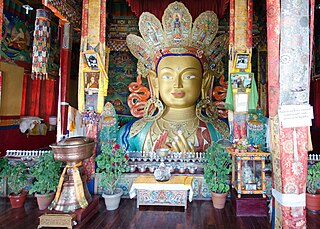
The vast majority of surviving Tibetan art created before the mid-20th century is religious, with the main forms being thangka, paintings on cloth, mostly in a technique described as gouache or distemper, Tibetan Buddhist wall paintings, and small statues in bronze, or large ones in clay, stucco or wood. They were commissioned by religious establishments or by pious individuals for use within the practice of Tibetan Buddhism and were manufactured in large workshops by monks and lay artists, who are mostly unknown. Various types of religious objects, such as the phurba or ritual dagger, are finely made and lavishly decorated. Secular objects, in particular jewellery and textiles, were also made, with Chinese influences strong in the latter.

A Thongdrel (མཐོང་གྲོལ།) is a large appliqué(གོས་དྲུབ།) religious image normally only unveiled during tsechus(ཚེ་བཅུ།), the main religious festivals in Bhutan. They are the largest form of thangka(ཐང་ཀ།) paintings in the tradition of Tibetan Buddhism. Thongdrels typically depict a seated Guru Rinpoche surrounded by holy beings in a composition that, unlike most smaller thangkas, is in a "landscape" format, somewhat wider than it is tall.

A thangka is a Tibetan Buddhist painting on cotton, silk appliqué, usually depicting a Buddhist deity, scene, or mandala. Thangkas are traditionally kept unframed and rolled up when not on display, mounted on a textile backing somewhat in the style of Chinese scroll paintings, with a further silk cover on the front. So treated, thangkas can last a long time, but because of their delicate nature, they have to be kept in dry places where moisture will not affect the quality of the silk. Most thangkas are relatively small, comparable in size to a Western half-length portrait, but some are extremely large, several metres in each dimension; these were designed to be displayed, typically for very brief periods on a monastery wall, as part of religious festivals. Most thangkas were intended for personal meditation or instruction of monastic students. They often have elaborate compositions including many very small figures. A central deity is often surrounded by other identified figures in a symmetrical composition. Narrative scenes are less common, but do appear.

The history of Asian art includes a vast range of arts from various cultures, regions, and religions across the continent of Asia. The major regions of Asia include Central, East, South, Southeast, and West Asia.

Tibet developed a distinct culture due to its geographic and climatic conditions. While influenced by neighboring cultures from China, India, and Nepal, the Himalayan region's remoteness and inaccessibility have preserved distinct local influences, and stimulated the development of its distinct culture.

Sherab Palden Beru was an exiled Tibetan thangka artist who played a key role in preserving the art-form through the training of western students over a period of more than four decades.

A paubhā is a traditional religious painting made by the Newar people of Nepal. Paubhas depict deities, mandalas or monuments, and are used to help the practitioners in meditation. The Tibetan equivalent is known as Thangka.
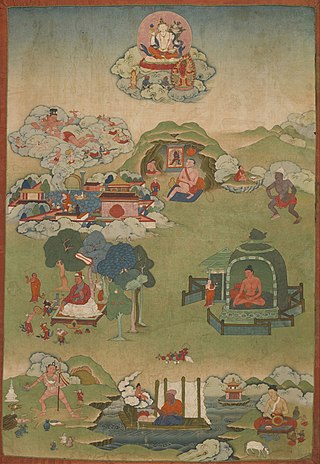
Tibetan tantric practice, also known as "the practice of secret mantra", and "tantric techniques", refers to the main tantric practices in Tibetan Buddhism. The great Rime scholar Jamgön Kongtrül refers to this as "the Process of Meditation in the Indestructible Way of Secret Mantra" and also as "the way of mantra," "way of method" and "the secret way" in his Treasury of Knowledge. These Vajrayāna Buddhist practices are mainly drawn from the Buddhist tantras and are generally not found in "common" Mahayana. These practices are seen by Tibetan Buddhists as the fastest and most powerful path to Buddhahood.

The Choijin Lama Temple is a Buddhist monastery in Ulaanbaatar, the capital of Mongolia.
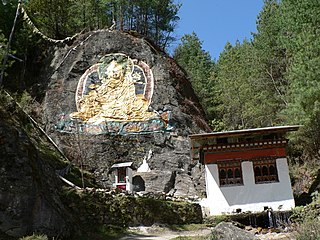
Bhutanese art ༼འབྲུག་པའི་སྒྱུ་རྩལ༽ is similar to Tibetan art. Both are based upon Vajrayana Buddhism and its pantheon of teachers and divine beings.

Tsakli are Tibetan Buddhist miniature paintings, normally produced as thematic groups or sets, which are used in rituals as initiation cards, and in the training of monks. Examples of this miniature art are also known from Mongolia.

Tabo Monastery is located in the Tabo village of Spiti Valley, Himachal Pradesh, northern India. It was founded in 996 CE in the Tibetan year of the Fire Ape by the Tibetan Buddhist lotsawa (translator) Rinchen Zangpo, on behalf of the king of western Himalayan Kingdom of Guge, Yeshe-Ö. Tabo is noted for being the oldest continuously operating Buddhist enclave in both India and the Himalayas. A large number of frescoes displayed on its walls depict tales from the Buddhist pantheon. There are many priceless collections of thankas, manuscripts, well-preserved statues, frescos and extensive murals which cover almost every wall. The monastery is in need of refurbishing as the wooden structures are aging and the thanka scroll paintings are fading. After the earthquake of 1975, the monastery was rebuilt, and in 1983 a new Du-kang or Assembly Hall was constructed. It is here that the 14th Dalai Lama held the Kalachakra ceremonies in 1983 and 1996. The monastery is protected by the Archaeological Survey of India (ASI) as a national historic treasure of India.

Zamthang County or Ndzamthang County, or Rangtang County is a county in the northwest of Sichuan Province, China, bordering on the Banma County of Qinghai Province to the north. It is one of 13 counties under the administration of and lies the westernmost county-level division of the Ngawa Tibetan and Qiang Autonomous Prefecture. Zamthang is on the upper reaches of the Dadu River, bordering the Barkam County and Ngawa County on the east and northeast, and adjoining Jinchuan County on the south, and Sêrtar County, Luhuo County and Dawu County in the west and south. Zamthang, which means "the field of Jambhala" in Tibetan, lies in the southeast of the Tibetan Plateau and in the historical region of Amdo. The vast majority of the population is Tibetan (30,200), followed by Han people (3949), Qiang people (269) and Hui people (78).
Gankhüügiin Pürevbat is a Mongolian painter, art collector, museum director and Buddhist teacher in the Vajrayana School. Lam Pürevbat is the founder of the Zanabazar Mongolian Institute of Buddhist Art. He was born in 1965 in Bornuur in the Töv Province.

Shashi Dhoj Tulachan, called Guru Nawang Chhogyall Tenzin, is the spiritual leader of the Chhairo gompa, of Nyingma Tibetan Buddhism, having been given responsibility for the Gompa by the current incarnation who is not a practising lama. He is also responsible for three gompas in Tukuche, his home village on the right bank of the Kali Gandaki, and in the Annapurna trail:
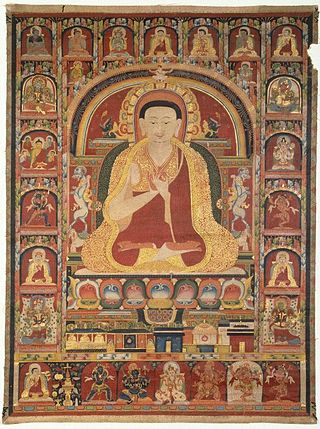
The conservation and restoration of Tibetan thangkas is the physical preservation of the traditional religious Tibetan painting form known as a thangka. When applied to thangkas of significant cultural heritage, this activity is generally undertaken by a conservator-restorer.
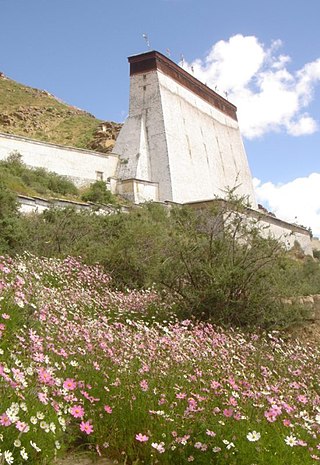
A thangka wall is, in Tibetan religious architecture, a stone-built structure used for hanging giant, or monumental, appliqued thangkas, or scrolls, in some of the major Buddhist monasteries of Tibet. These giant thangkas are called gos ku, goku, gheku, kiku in Tibetan, and thongdrel in Bhutan. The thangka wall stands on a hillside from where it overlooks the monastic settlement. Its form is that of a narrow, elongated and tall rectangular building with a battered façade and a flat roof surrounded by a parapet. The side and rear walls are normally vertical.



















